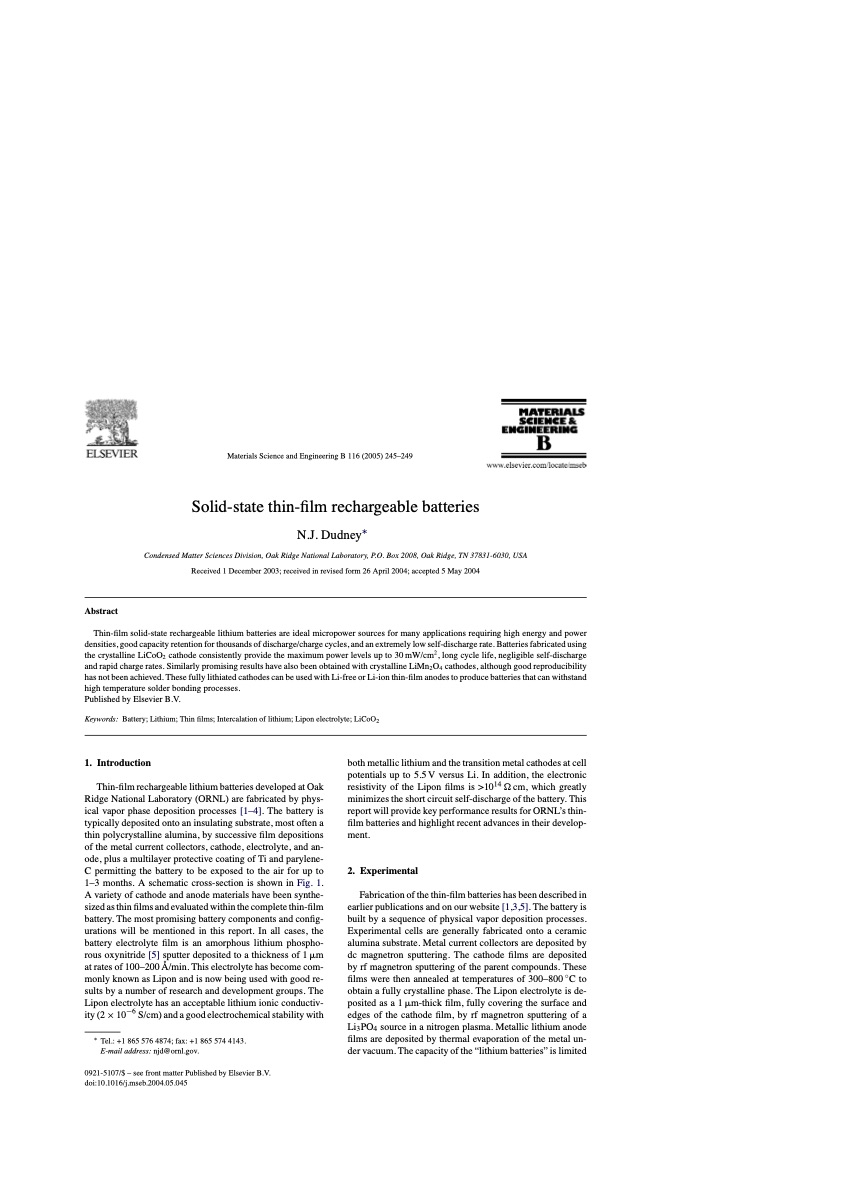
PDF Publication Title:
Text from PDF Page: 001
Abstract Materials Science and Engineering B 116 (2005) 245–249 Solid-state thin-film rechargeable batteries N.J. Dudney∗ Condensed Matter Sciences Division, Oak Ridge National Laboratory, P.O. Box 2008, Oak Ridge, TN 37831-6030, USA Received 1 December 2003; received in revised form 26 April 2004; accepted 5 May 2004 Thin-film solid-state rechargeable lithium batteries are ideal micropower sources for many applications requiring high energy and power densities, good capacity retention for thousands of discharge/charge cycles, and an extremely low self-discharge rate. Batteries fabricated using the crystalline LiCoO2 cathode consistently provide the maximum power levels up to 30mW/cm2, long cycle life, negligible self-discharge and rapid charge rates. Similarly promising results have also been obtained with crystalline LiMn2O4 cathodes, although good reproducibility has not been achieved. These fully lithiated cathodes can be used with Li-free or Li-ion thin-film anodes to produce batteries that can withstand high temperature solder bonding processes. Published by Elsevier B.V. Keywords: Battery; Lithium; Thin films; Intercalation of lithium; Lipon electrolyte; LiCoO2 1. Introduction Thin-film rechargeable lithium batteries developed at Oak Ridge National Laboratory (ORNL) are fabricated by phys- ical vapor phase deposition processes [1–4]. The battery is typically deposited onto an insulating substrate, most often a thin polycrystalline alumina, by successive film depositions of the metal current collectors, cathode, electrolyte, and an- ode, plus a multilayer protective coating of Ti and parylene- C permitting the battery to be exposed to the air for up to 1–3 months. A schematic cross-section is shown in Fig. 1. A variety of cathode and anode materials have been synthe- sized as thin films and evaluated within the complete thin-film battery. The most promising battery components and config- urations will be mentioned in this report. In all cases, the battery electrolyte film is an amorphous lithium phospho- rous oxynitride [5] sputter deposited to a thickness of 1 m atratesof100–200A ̊/min.Thiselectrolytehasbecomecom- monly known as Lipon and is now being used with good re- sults by a number of research and development groups. The Lipon electrolyte has an acceptable lithium ionic conductiv- ity (2 × 10−6 S/cm) and a good electrochemical stability with ∗ Tel.:+18655764874;fax:+18655744143. E-mail address: njd@ornl.gov. 0921-5107/$ – see front matter Published by Elsevier B.V. doi:10.1016/j.mseb.2004.05.045 both metallic lithium and the transition metal cathodes at cell potentials up to 5.5 V versus Li. In addition, the electronic resistivity of the Lipon films is >1014 cm, which greatly minimizes the short circuit self-discharge of the battery. This report will provide key performance results for ORNL’s thin- film batteries and highlight recent advances in their develop- ment. 2. Experimental Fabrication of the thin-film batteries has been described in earlier publications and on our website [1,3,5]. The battery is built by a sequence of physical vapor deposition processes. Experimental cells are generally fabricated onto a ceramic alumina substrate. Metal current collectors are deposited by dc magnetron sputtering. The cathode films are deposited byrfmagnetronsputteringoftheparentcompounds.These films were then annealed at temperatures of 300–800 ◦ C to obtain a fully crystalline phase. The Lipon electrolyte is de- posited as a 1 m-thick film, fully covering the surface and edges of the cathode film, by rf magnetron sputtering of a Li3PO4 source in a nitrogen plasma. Metallic lithium anode films are deposited by thermal evaporation of the metal un- der vacuum. The capacity of the “lithium batteries” is limitedPDF Image | Solid-state thin-film rechargeable batteries

PDF Search Title:
Solid-state thin-film rechargeable batteriesOriginal File Name Searched:
120311.pdfDIY PDF Search: Google It | Yahoo | Bing
Sulfur Deposition on Carbon Nanofibers using Supercritical CO2 Sulfur Deposition on Carbon Nanofibers using Supercritical CO2. Gamma sulfur also known as mother of pearl sulfur and nacreous sulfur... More Info
CO2 Organic Rankine Cycle Experimenter Platform The supercritical CO2 phase change system is both a heat pump and organic rankine cycle which can be used for those purposes and as a supercritical extractor for advanced subcritical and supercritical extraction technology. Uses include producing nanoparticles, precious metal CO2 extraction, lithium battery recycling, and other applications... More Info
| CONTACT TEL: 608-238-6001 Email: greg@infinityturbine.com | RSS | AMP |